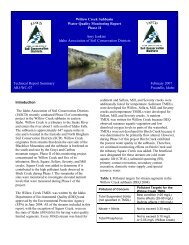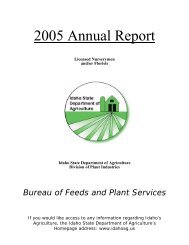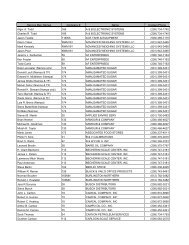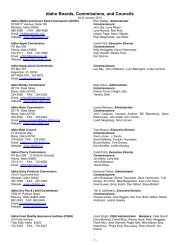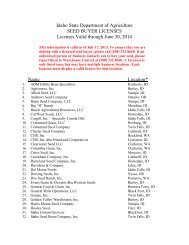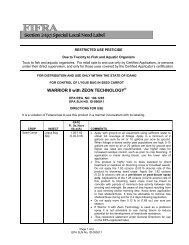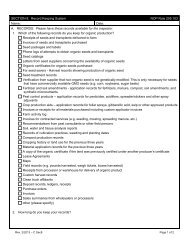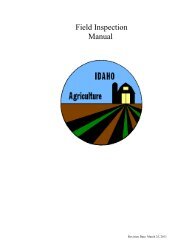2008 Statewide Strategic Plan for Eurasian Watermilfoil in Idaho
2008 Statewide Strategic Plan for Eurasian Watermilfoil in Idaho
2008 Statewide Strategic Plan for Eurasian Watermilfoil in Idaho
Create successful ePaper yourself
Turn your PDF publications into a flip-book with our unique Google optimized e-Paper software.
the boat with a GPS to the predeterm<strong>in</strong>ed po<strong>in</strong>t and a second person makes<br />
observations. Depth and, if possible, the sediment type (mud, sand, rock, or<br />
organic) are also recoded at each sampl<strong>in</strong>g po<strong>in</strong>t. The reader observes an area<br />
of water over the side of the boat us<strong>in</strong>g the same side of the boat every time.<br />
Species observed from the surface with<strong>in</strong> the area are recorded on a data sheet.<br />
A sample rake is used <strong>in</strong> areas where the bottom cannot be clearly seen (Figure<br />
13). Sample with two rake throws <strong>in</strong> a cross<strong>in</strong>g pattern with<strong>in</strong> a 1m x 1m sampl<strong>in</strong>g<br />
area and record all species (Parsons et al. 2001). Any <strong>Eurasian</strong> watermilfoil that<br />
is observed while travel<strong>in</strong>g between sampl<strong>in</strong>g po<strong>in</strong>ts is also recorded.<br />
A species is only recorded once at each sampl<strong>in</strong>g po<strong>in</strong>t, even if it is observed<br />
multiple times on the surface and <strong>in</strong> rake throws. The data sheets are arranged<br />
with all suspected species listed across the top and sample coord<strong>in</strong>ates listed <strong>in</strong><br />
the left column. When a species is found, a 1 is marked <strong>in</strong> the appropriate column<br />
<strong>for</strong> that species. A 0 is entered to <strong>in</strong>dicate the absence of a species at that po<strong>in</strong>t.<br />
Spaces are available <strong>for</strong> list<strong>in</strong>g new species as they are found. A column is<br />
provided to list various physical states of <strong>Eurasian</strong> watermilfoil <strong>in</strong> order to gage the<br />
effectiveness of treatments. A scale of 1 through 5 is used to record the status of<br />
plants observed. 5 <strong>in</strong>dicates no live <strong>Eurasian</strong> watermilfoil present, 4 <strong>in</strong>dicates only<br />
a small sprig of <strong>Eurasian</strong> watermilfoil (very little live <strong>Eurasian</strong> watermilfoil present),<br />
3 <strong>in</strong>dicates sparse <strong>Eurasian</strong> watermilfoil (plants appear stressed, sparse growth,<br />
no plants on the surface), 2 <strong>in</strong>dicates <strong>Eurasian</strong> watermilfoil but not on water<br />
surface (some plants appear distressed but fairly healthy, no plants on the<br />
surface) and 1 <strong>in</strong>dicates <strong>Eurasian</strong> watermilfoil on surface (plants appear fairly<br />
healthy with little to no apparent control effects, plants on water surface). In<br />
addition, a column is provided <strong>for</strong> a cover estimate. Cover is reported as either<br />
dense, sparse, or no <strong>Eurasian</strong> watermilfoil cover.<br />
In small lakes pre- and post-treatment po<strong>in</strong>t <strong>in</strong>tercept surveys are conducted over<br />
the entire water body. The pre-treatment survey is conducted be<strong>for</strong>e treatments<br />
are applied, preferably with<strong>in</strong> several weeks prior to treatment. The posttreatment<br />
survey revisit the same po<strong>in</strong>ts and are conducted late <strong>in</strong> the year (late<br />
August or September) <strong>in</strong> order to assure the maximum treatment effect is<br />
observed. In small lakes the pre-treatment survey can be conducted concurrently<br />
with the littoral survey.<br />
Surveys conducted <strong>in</strong> large lakes that receive <strong>Eurasian</strong> watermilfoil treatments<br />
may have two types of po<strong>in</strong>t <strong>in</strong>tercept surveys conducted:<br />
Pre/Post Treatment Po<strong>in</strong>t Intercept Survey: The pre/post po<strong>in</strong>t <strong>in</strong>tercept<br />
survey consists of multiple sampl<strong>in</strong>g po<strong>in</strong>ts arranged <strong>in</strong> areas where<br />
<strong>Eurasian</strong> watermilfoil treatments are planned. The po<strong>in</strong>ts are established <strong>in</strong><br />
the treatment areas and are monitored be<strong>for</strong>e and after treatments <strong>in</strong> order<br />
to quantify treatment efficacy (Madsen 2006). Po<strong>in</strong>ts are arranged <strong>in</strong> either<br />
a regular grid pattern or <strong>in</strong> a random distribution, depend<strong>in</strong>g on the size of<br />
the treatment area. ISDA provides maps and sample po<strong>in</strong>t locations to the<br />
24



